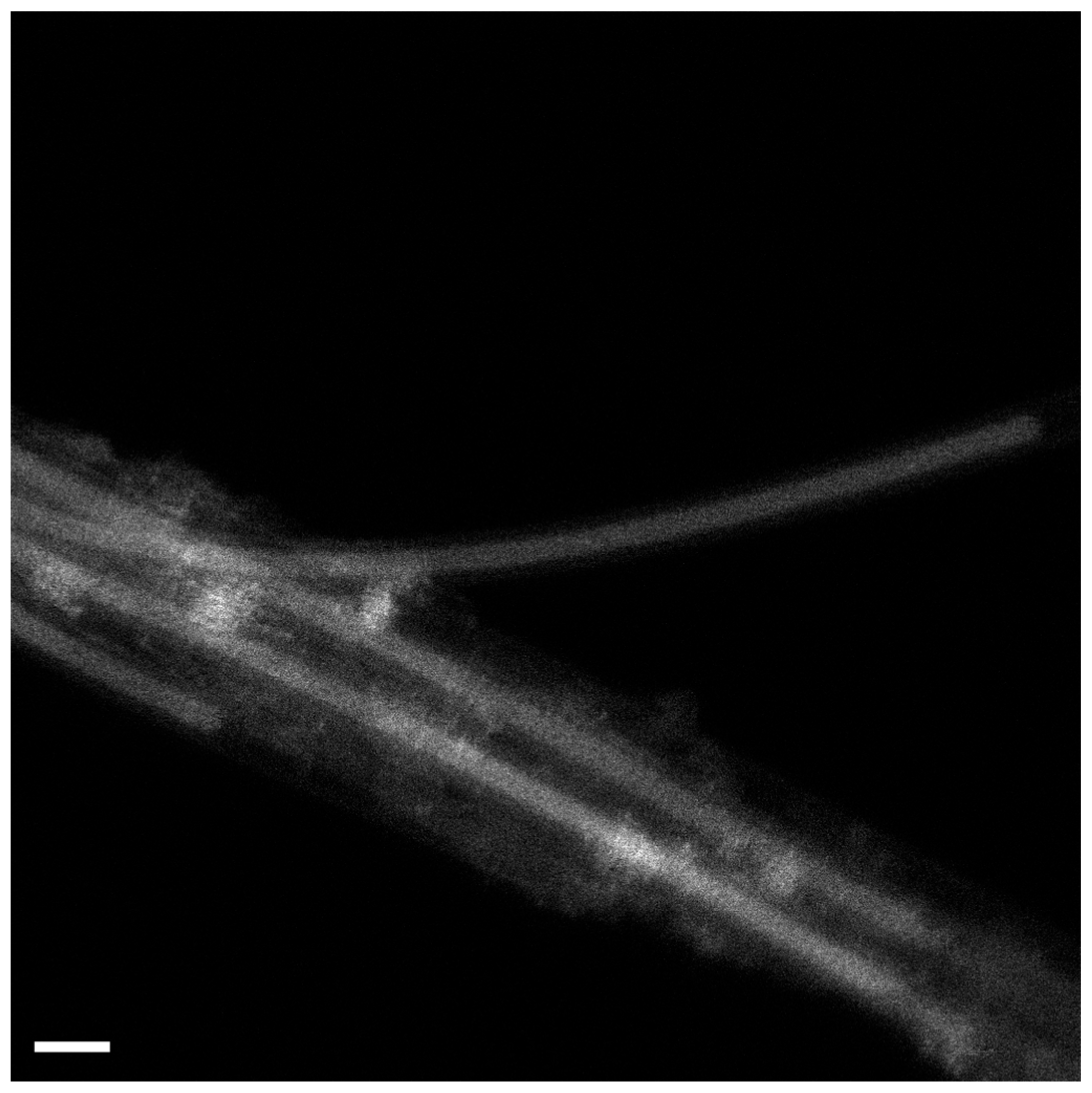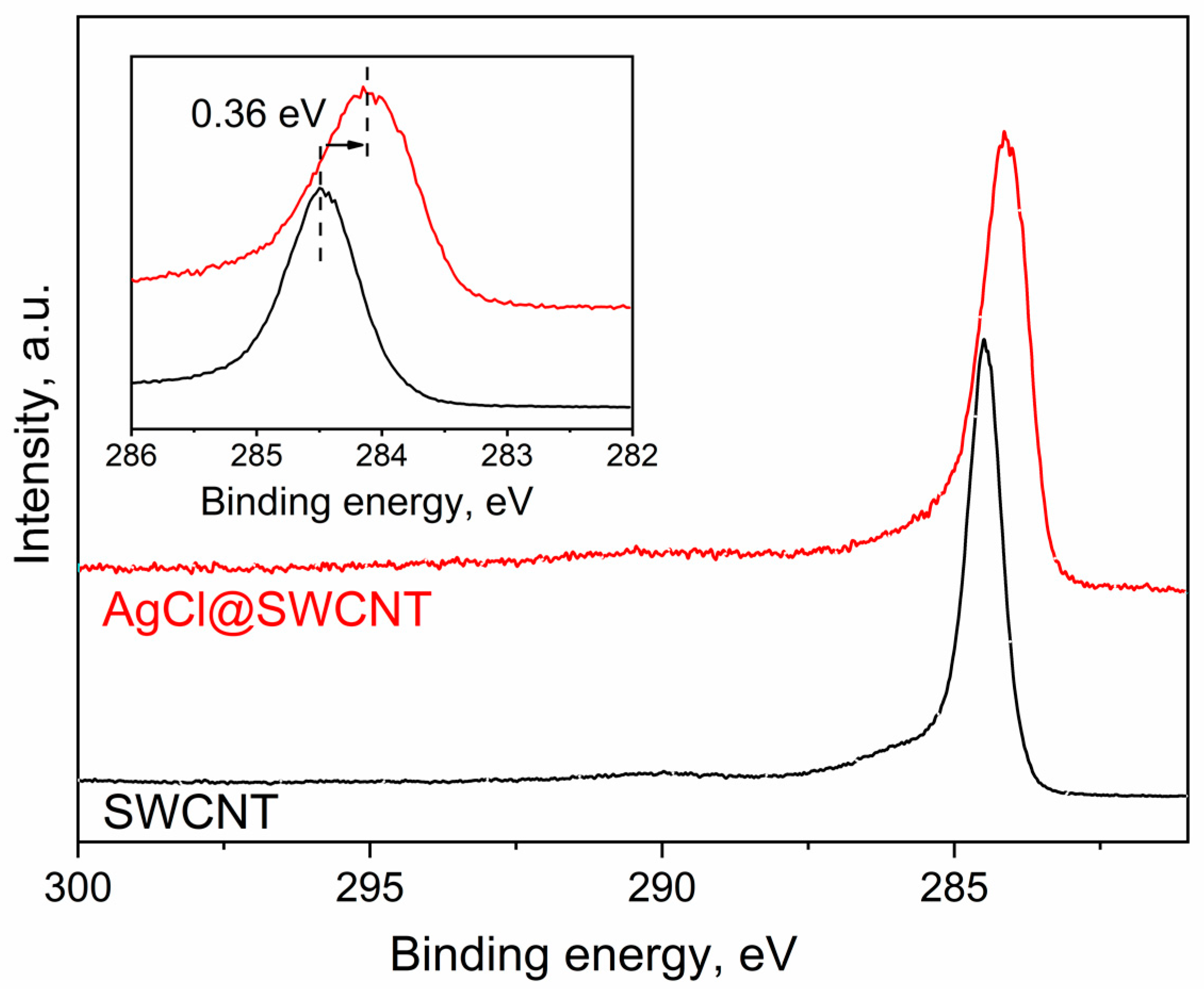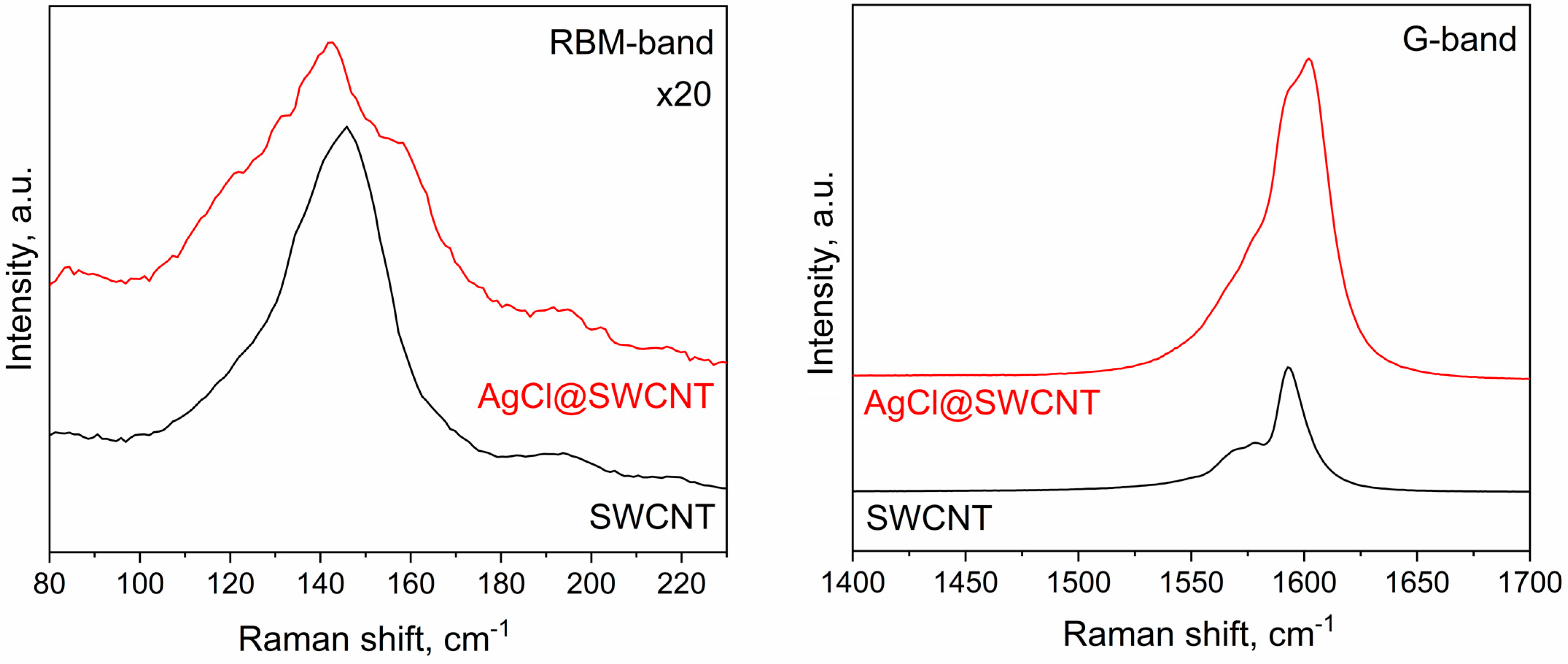Photoemission Insight to Filling of Large 1.7 nm Diameter Single-Walled Carbon Nanotubes with Silver Chloride †
Abstract
:1. Introduction
2. Experimental Section
3. Results
4. Conclusions
Funding
Institutional Review Board Statement
Informed Consent Statement
Data Availability Statement
Acknowledgments
Conflicts of Interest
References
- Kharlamova, M.V. Kinetics, Electronic Properties of Filled Carbon Nanotubes Investigated with Spectroscopy for Applications. Nanomaterials 2022, 13, 176. [Google Scholar] [CrossRef]
- Kharlamova, M.V.; Kramberger, C. Metallocene-Filled Single-Walled Carbon Nanotube Hybrids. Nanomaterials 2023, 13, 774. [Google Scholar] [CrossRef]
- Kharlamova, M.V.; Kramberger, C. Applications of Filled Single-Walled Carbon Nanotubes: Progress, Challenges, and Perspectives. Nanomaterials 2021, 11, 2863. [Google Scholar] [CrossRef]
- Kharlamova, M.V.; Kramberger, C. Electrochemistry of Carbon Materials: Progress in Raman Spectroscopy, Optical Absorption Spectroscopy, and Applications. Nanomaterials 2023, 13, 640. [Google Scholar] [CrossRef] [PubMed]
- Paukov, M.; Kramberger, C.; Begichev, I.; Kharlamova, M.; Burdanova, M. Functionalized Fullerenes and Their Applications in Electrochemistry, Solar Cells, and Nanoelectronics. Materials 2023, 16, 1276. [Google Scholar] [CrossRef] [PubMed]
- Kharlamova, M.V.; Kramberger, C. Phemenology of filling, investigation of growth kinetics and electronic properties for ap-plications of filled single-walled carbon nanotubes. Nanomaterials 2023, 13, 314. [Google Scholar] [CrossRef]
- Kharlamova, M.V.; Kramberger, C. Metal and Metal Halogenide-Filled Single-Walled Carbon Nanotubes: Kinetics, Electronic Properties, Engineering the Fermi Level. Nanomaterials 2023, 13, 180. [Google Scholar] [CrossRef] [PubMed]
- Burdanova, M.G.; Tsapenko, A.P.; Kharlamova, M.V.; Kauppinen, E.I.; Gorshunov, B.; Kono, J.; Lloyd-Hughes, J. A review of the terahertz conductivity and photoconductivity of nanotubes and related materials. Adv. Opt. Mater. 2021, 9, 2101042. [Google Scholar] [CrossRef]
- Kharlamova, M.V. Nickelocene-filled purely metallic single-walled carbon nanotubes: Sorting and tuning the electronic prop-erties. Nanomaterials 2021, 11, 2500. [Google Scholar] [CrossRef]
- Sizikov, A.A.; Kharlamova, M.V.; Nikitin, P.I.; Nikitin, M.P. Non-viral locally injected magnetic vectors for in vivo gene delivery: A review of studies on magnetofection. Nanomaterials 2021, 11, 1078. [Google Scholar] [CrossRef]
- Kharlamova, M.V.; Kramberger, C.; Eder, D. Tuning the Electronic Properties of Single-Walled Carbon Nanotubes by Filling with Electron Donor and Acceptor Compounds. Mater. Proc. 2021, 4, 67. [Google Scholar] [CrossRef]
- Kharlamova, M.V.; Eder, D. Carbon nanotubes: Synthesis, properties and new developments in research. In Synthesis and Applications of Nanocarbons; Arnault, J.C., Eder, D., Eds.; John Wiley & Sons: Hoboken, NJ, USA, 2021; pp. 107–147. [Google Scholar]
- Kharlamova, M.V. Novel approaches to synthesis of double-walled carbon nanotubes. In Handbook of Carbon Nanotubes; Abraham, J., Kalarikkal, N., Thomas, S., Eds.; Springer: Berlin/Heidelberg, Germany, 2020; pp. 1–21. [Google Scholar]
- Kharlamova, M.V.; Kramberger, C.; Rudatis, P.; Yanagi, K.; Eder, D. Characterization of the electronic properties of single-walled carbon nanotubes filled with an electron donor—Rubidium iodide: Multifrequency Raman and X-ray photoelectron spectros-copy studies. Phys. Status Solidi B 2019, 256, 1900209. [Google Scholar] [CrossRef]
- Kharlamova, M.V.; Kramberger, C.; Rudatis, P.; Pichler, T.; Eder, D. Revealing the doping effect of encapsulated lead halogenides on single-walled carbon nanotubes. Appl. Phys. A 2019, 125, 320. [Google Scholar] [CrossRef]
- Kharlamova, M.V. Novel approach to tailoring the electronic properties of single-walled carbon nanotubes by the encapsulation of high-melting gallium selenide using a single-step process. JETP Lett. 2013, 98, 272–277. [Google Scholar] [CrossRef]
- Kharlamova, M.V.; Yashina, L.V.; Eliseev, A.A.; Volykhov, A.A.; Neudachina, V.S.; Brzhezinskaya, M.M.; Zyubina, T.S.; Lukashin, A.V.; Tretyakov, Y.D. Single-walled carbon nanotubes filled with nickel halogenides: Atomic structure and doping effect. Phys. Status Solidi B 2012, 249, 2328–2332. [Google Scholar] [CrossRef]
- Kharlamova, M.V.; Kramberger, C.; Saito, T.; Sato, Y.; Suenaga, K.; Pichler, T.; Shiozawa, H. Chirality-dependent growth of single-wall carbon nanotubes as revealed inside nano-test tubes. Nanoscale 2017, 9, 7998–8006. [Google Scholar] [CrossRef]
- Kharlamova, M.V.; Brzhezinskay, M.M.; Vinogradov, A.S.; Suzdalev, I.P.; Maksimov, Y.V.; Imshennik, V.K.; Novichikhin, S.V.; Krestinin, A.V.; Yashina, L.V.; Lukashin, A.V.; et al. The formation and properties of one-dimensional FeHal2 (Hal = Cl, Br, I) nanocrystals in channels of single-walled carbon nanotubes. Nanotechnol. Russ. 2009, 4, 634–646. [Google Scholar] [CrossRef]
- Kharlamova, M.V.; Kramberger, C.; Domanov, O.; Mittelberger, A.; Yanagi, K.; Pichler, T.; Eder, D. Endohedral Functionalization of Metallicity-Sorted Single-Walled Carbon Nanotubes. Proceedings 2020, 56, 33. [Google Scholar] [CrossRef]
- Kharlamova, M.V.; Kramberger, C.; Domanov, O.; Mittelberger, A.; Yanagi, K.; Pichler, T.; Eder, D. Fermi level engineering of metallicity-sorted metallic single-walled carbon nanotubes by encapsulation of few-atom-thick crystals of silver chloride. J. Mater. Sci. 2018, 53, 13018–13029. [Google Scholar] [CrossRef]
- Kharlamova, M.V.; Kramberger, C.; Mittelberger, A.; Yanagi, K.; Pichler, T.; Eder, D. Silver Chloride Encapsulation-Induced Modifications of Raman Modes of Metallicity-Sorted Semiconducting Single-Walled Carbon Nanotubes. J. Spectrosc. 2018, 2018, 5987428. [Google Scholar] [CrossRef]
- Kirchhoff, F.; Holender, J.M.; Gillan, M.J. Energetics and electronic structure of silver chloride. Phys. Rev. B 1994, 49, 17420–17423. [Google Scholar] [CrossRef] [PubMed]



Disclaimer/Publisher’s Note: The statements, opinions and data contained in all publications are solely those of the individual author(s) and contributor(s) and not of MDPI and/or the editor(s). MDPI and/or the editor(s) disclaim responsibility for any injury to people or property resulting from any ideas, methods, instructions or products referred to in the content. |
© 2023 by the author. Licensee MDPI, Basel, Switzerland. This article is an open access article distributed under the terms and conditions of the Creative Commons Attribution (CC BY) license (https://creativecommons.org/licenses/by/4.0/).
Share and Cite
Kharlamova, M.V. Photoemission Insight to Filling of Large 1.7 nm Diameter Single-Walled Carbon Nanotubes with Silver Chloride. Eng. Proc. 2023, 37, 46. https://doi.org/10.3390/ECP2023-14622
Kharlamova MV. Photoemission Insight to Filling of Large 1.7 nm Diameter Single-Walled Carbon Nanotubes with Silver Chloride. Engineering Proceedings. 2023; 37(1):46. https://doi.org/10.3390/ECP2023-14622
Chicago/Turabian StyleKharlamova, Marianna V. 2023. "Photoemission Insight to Filling of Large 1.7 nm Diameter Single-Walled Carbon Nanotubes with Silver Chloride" Engineering Proceedings 37, no. 1: 46. https://doi.org/10.3390/ECP2023-14622
APA StyleKharlamova, M. V. (2023). Photoemission Insight to Filling of Large 1.7 nm Diameter Single-Walled Carbon Nanotubes with Silver Chloride. Engineering Proceedings, 37(1), 46. https://doi.org/10.3390/ECP2023-14622




